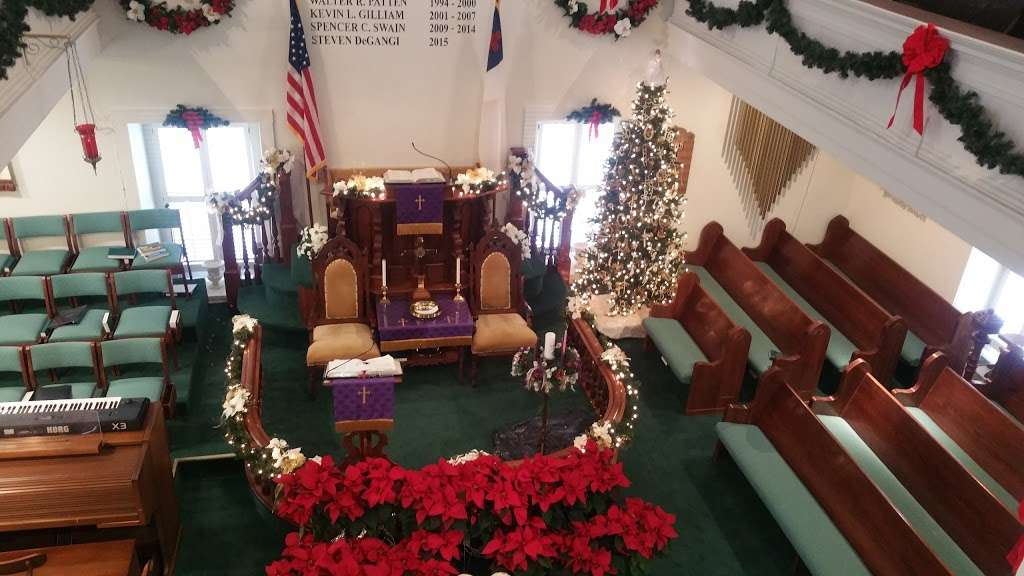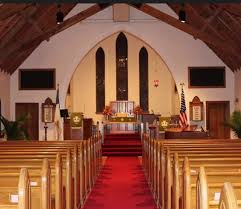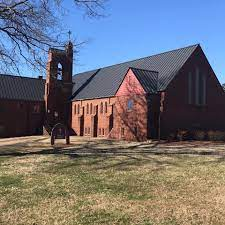Anglicans tend to worry about liturgy in the same way that cage-stage Calvinists worry about the Ordo Salutis – obsessively. This can blind them to the fact that the Eucharistic Rite of the Book of Common Prayer is not a unique creation, but the product of the widespread endeavor to reform the liturgy in accordance with the principles of the Protestant Reformation. One of the more interesting byways that I have discovered thanks to the UECNA’s engagement with former Evangelical and Reformed congregations is the strong “family resemblance” of their Eucharistic rite to the two main Anglican Orders. Both Anglicanism, and the Evangelical and Reformed Church evolved from bodies which succeeded in reconciling the Lutheran and Reformed impulses within the Reformation, so it should come as no surprise that – like the Windsors and the Hohenzollerns – the two churches ended up with a strong resemblance to one another not just in terms of theology, but liturgy.
What was the Evangelical and Reformed Church?
The Evangelical and Reformed Church existed for only 23 years. It was formed by a 1934 merger between two churches with German origins – the Reformed Church in the United States and the Evangelical Synod of North America, which had only dropped the word German from their denominational titles in the previous decade. The older denomination, the Reformed Church in the United States (RCUS), developed from congregations formed in North Carolina, Virginia, and Pennsylvania around 1700 in the wake of immigration from Nassau, the Palatinate, or other German states affected by the almost continuous warfare between France and Austria. The generally accepted date for the foundation of the denomination – 1725 – is largely a matter of convenience for historians as that is when the German Reformed first organized as a recognizable Church Body affiliated with the Amsterdam Classis of the Dutch Reformed Church despite their minor differences of worship and belief. The German Reformed used the Palatine Liturgy[1] and based their doctrine on the Heidelburg Catechism, the Small Catechism of Martin Luther, and the Augsburg Confession, and were at what Philip Schaff described as the “unionistic” end of the Reformed tradition. This moderate stance was probably reinforced by the many Union Churches[2] Pressure to adopt the ‘Three Forms of Unity’ along with other tensions with the Amsterdam Classis caused the German Reformed to break the link in the immediate wake of the Revolutionary War, whilst the steady influx of German immigrants after the Napoleonic Wars enabled the denomination to move westwards with the expanding United States into Ohio, Michigan, and Illinois.
The other denomination involved in the 1934 merger was the Evangelical Synod in North America which evolved out of the United Churches in Hesse, Nassau, and Baden rather than out of the Prussian Evangelical Church.[3] Unlike the Prussian Union, which was an expression of the royal will, the creation of these union churches had been driven by the desires of the people and pastors. Following the immigration patterns of the 1830s and 1840s, the Evangelical Synod was most prevalent in the Midwest where it faced opposition not just from German Rationalists who wanted no church at all, but the Old Lutherans who had gone to North America to escape ‘the Union Church.’
Both churches were inclined to be liturgical. The RCUS side had originally used the Palatine Liturgy, but in the 1840s and 1850s Philip Schaff, John Williamson Nevin, and other members of the Mercersburg faculty had labored to produce the Mercersburg Liturgy drawing not just on the Palatine Liturgy but on ancient liturgies and the Book of Common Prayer.[4] Its appearance in 1856 generated pro- and anti-factions within the RCUS. Counterproposals were made and it was to be a generation before a settlement was reached in which the Union Liturgy – largely drawn from Mercersburg – was regarded as the standard, but considerable latitude was allowed in its use.
The Evangelical Synod’s liturgical customs tended to follow the ‘loose Lutheranism’ of its parent churches. The late 1700s had not been a happy time for Lutheran Liturgy, and often what survived was little more than a ‘shape’ – Trinitarian invocation, General Confession, Absolution, Hymn of Praise, Collect, Lesson, Creedal Hymn, Sermon, General Prayer, Lord’s Prayer, and Blessing. The ESNA’s Order of Worship was very much of that type and bore a family resemblance to that issued by the Pennsylvania Ministerium in 1748, but with a tendency to linguistic expansiveness in accordance with the Pietism of the 19th-century emigrants.[5] The Order of Communion in the Evangelical Book of Worship was basically that of the Rhine provinces with little more than a communion exhortation, the Lord’s Prayer, the Words of Institution, and “O Lamb of God most holy” being added to the regular service.
The 1947 Book of Worship
After the 1934 merger, the Evangelical and Reformed Church worked its way through the constitutional and legal issues emerging from the union, so it was some thirteen years before a joint liturgy – ‘The Book of Worship’ – appeared. In addition to the occasional offices this book contained an order for Morning Worship, an Alternative Order of Worship, an Evening Service, The Preparatory Service, The Order of Holy Communion, and the Alternative Order of Holy Communion. It is with the Order of Morning Worship and the two Eucharistic Rites that this article is concerned.
In terms of their historical origin, both orders share much with the Prayer Book with the influence of the Brandenburg Church-Order of 1540, Bucer’s Church-Order for Strassburg, and the Simple and Religious Consultation of Hermann von Weid (1543) all being evident. In common with the Scottish Liturgy, a pronounced Patristic influence in the form of the Pseudo-Clementine Liturgy is evident, whilst Anglican influence filtered into the liturgy once more via both the Prussian Agenda of 1829 which Schaff would have encountered in Germany when studying there in the 1830s, as well as from the 1789 PECUSA Prayer Book. It was these influences together with the Palatine Liturgy in the Mercersburg Liturgy that formed a basis, not just the Union Liturgy of 1887. This liturgy, augmented by the Lutheran traditions of the Evangelical Synod, was revised to make the Evangelical and Reformed Book of Worship in 1947.
Architectural Setting
Both the RCUS and the ESNA followed the usual trends of American Protestant church architecture with the Classicism of the Colonial and Federal Periods gradually giving way to the Gothic Revival. Centre pulpits combined with the altar were common in the earlier period, but with the stronger liturgical sensibility fostered in the churches in the late 19th century, this plan gradually gave way to short, wide chancels with the lectern and pulpit placed right and left at the entrance and the altar or communion table against the ‘east’ wall. In Evangelical & Reformed churches the communion table, or occasionally, altar, commonly carried a frontal, two candles and a cross, and in many churches were surrounded by rails. The main visual difference between Anglican practice of the period and that of the E&R would be the occasional lack of rails and the minister’s vesture which was usually gown and stole, though occasionally former Evangelical Synod ministers in surplice and stole due to the Unionist-Lutheran basis of their former denomination. The minister took the Eastward position to celebrate the Eucharist.

Above: Grace Lower Stone E & R Church, NC, showing the typical early 19th-century sanctuary arrangement which here has survived subsequent re-pewing.
Below: A typical ‘Mercersburg’ Sanctuary – Paul’s Chapel Reformed Church (1949), now part of the Evangelical and Reformed Society of the Anglican Protestant Church (UECNA). Interior and exterior.


Below: Evening Service and the Installation of a Pastor, Boger Reformed Church, Concord, NC. Clergy vested in the usual E&R manner.

The Preparatory Service
One characteristic of the Evangelical and Reformed rite was the preparatory service held either the day or the week before the celebration of the Eucharist. This started out in the Reformed tradition but crossed over into Lutheranism as the former practice of auricular confession died out under the influence of Pietism, and later Rationalism. The Evangelical and Reformed version of the Preparatory Service consisted of the Ten Commandments, the Litany (very similar to the 1789/1928 BCP form), Sermon, Exhortation, General Confession, an interrogation, and Absolution. After this service communion tokens were given out and were collected by the deacons at the actual communion service – a practice once common in the Scottish Episcopal Church. The tokens issued at the preparatory service would then be handed in before the actual Communion service, and a new token issued signifying actual attendance which would be collected later. This practice is analogous to the Prayer Book requirement intending communicants to “signify their names to the Curate.”
Morning Worship
To get a complete picture of the Evangelical and Reformed rite it is necessary to look at both the regular Sunday Service and the Alternate Order, as well as the full Order of Holy Communion. The Order of Morning Service is patterned after the Liturgy of the Word, or Ante-Communion, as was normal for the Middle and Lower German Lands[6] where the non-eucharistic ‘dry’ service was usually a truncated version of the Eucharistic liturgy. The Evangelical Synod, however, followed the general German custom and used a version of Ante-Communion. When the E&R Book of Worship was produced, the new Order of Morning Service merged the forms used by the parent denominations giving us the RCUS words in the ESNA order.
The service opens with the Trinitarian Invocation and a sentence of Scripture with the list of texts provided being very similar to that provided at the beginning of Morning Prayer in the 1928 Prayer Book. The Pastor then bids the congregation to confess their sins which they do using either the General Confessions from the old Mercersburg Liturgy (RCUS), or that from the BCP (ESNA). The Kyrie[7] is then sung or said after which follow comfortable words, which are not those of the BCP, and the Absolution, which is slightly more emphatic than that of the BCP as to the power of the keys. Provision is made for the Introit to be sung or said.
“O Lord, open thou my lips,” and the response, “And my mouth shall show forth thy praise” follow leading into the Gloria in Excelsis, for which the Hymnal gives the familiar Old Scottish Chant, or some other hymn of praise. The Evangelical Synod influence can again be seen in that the Collect, Epistle, and Gospel follow in the traditional order, rather than being reversed as was the case in the previous RCUS book. The collects and lessons are usually the same as those given in the 1789 Book of Common Prayer, but there are a handful of substitutions. The rubrics allow the option of placing a psalm or responsive reading, between the Collect and the Epistle. Gospel is read with the option of using the traditional responses and is followed by the Apostles’ Creed, which is given both in the traditional text and in the characteristic German form referring to ‘the one Holy Universal Church.’[8]
After the Creed, the General Prayer follows being introduced by the usual salutation “The Lord be with you” – “And with thy spirit.” Although the rubrics allow some flexibility, the prayers printed in the book under the heading of the General Prayer are a General Thanksgiving (based on the one in the BCP); a Prayer for Spiritual Victory, a Prayer for the Church Universal, a Prayer for the President, etc., and a Prayer for All Sorts and Conditions -again derived from the BCP. Special or additional prayers may be offered for the specific needs of the time or congregation, and this section of the service ends with the familiar Prayer of St Chrysostom. An anthem, the offering, a hymn, and the sermon then follow, and the service concludes with a final prayer, the Lord’s Prayer, and a blessing in the form of either the familiar Grace, or the Aaronic Blessing which is used in the Commination/Penitential Office of the BCP.
The Order of Holy Communion
Although it was less frequently used than the Alternative Form, the Order of Holy Communion was placed first in the Book of Worship, and represents a slightly revised version of the Reformed Church, U.S. Liturgy. It commences with the Trinitarian invocation ‘In the name of Father, and of the Son, and of the Holy Spirit.’ This is followed by an Exhortation to worthy Communion similar in its themes to the one on p.85 of the 1928 BCP. The rest of the ante-Communion service down to the Creed is basically identical to that of the normal Morning Service, but the first form of the General Confession derives from the BCP whilst the second resembles the Lutheran, and there is no permission for a Psalm or responsive reading after the Collect of the Day.
The reading of Scripture is followed by either the Apostles’ Creed or the Nicene Creed in the ‘We’ form. After the Creed, the Sermon is preached, a hymn is sung, the Offerings received, and permission is given for the choir to sing an anthem. The rubrics then say, “Then, the vessels containing bread[9] and wine having been made ready, and the congregation standing, the service proceeds” which is equivalent to the rubric after the Sanctus in the 1928 BCP. The Minister then says the Sursum Corda followed by a lengthy Preface which gives thanks for the Incarnation, the atonement, the resurrection, ascension, for coming of the Holy Spirit, and for the institution of the Church. The memorial aspect of the Eucharist but with a heavy emphasis on the salvific effects of the incarnation as befits the Mercersburg theological tradition.
The Sanctus – with or without the Benedictus qui Venit – then follows, after which there is a brief Prayer of Consecration, equivalent to the first three paragraphs of the 1928 Prayer of Consecration. The custom in the E&R Church was for the eastward position to be used with manual acts like those of the Prayer Book. Like the Scottish BCP, the Prayer for the Church follows the consecration and includes a passage reminiscent of the Commemoration of the faithful departed in the 1549 BCP. It reads:
We praise thee for the fellowship of the holy Patriarchs and Prophets, apostles and martyrs, and the whole glorious company of the redeemed of all ages, who have died in the Lord, and now live with him forevermore.
The Lord’s Prayer is said in the debts/debtors form, followed by the Agnus Dei, and the Peace with no ‘sign.’ The invitation to communion takes the form of the familiar St. Matt. 11.28, “Come unto me, all ye that labour…”
Communion then follows with the minister and his assistants receiving the Wine from the Common Cup and the rest of the lay communicants from communion glasses, though the rubrics mandate the Common Cup for all.[10] The words of administration are given in two forms, one deriving directly from 1 Corinthians 11, and the other from the Words of Institution. When all the Communicants have received the minister formally dismisses them. The unused elements are covered with a linen cloth, echoing BCP practice, and a Prayer of Thanksgiving then follows which is very close to that in the 1928 BCP, whilst the ‘Hymn’ after communion is either the Nunc Dimittis, echoing Lutheran practice, and the ‘Te Deum’ of the Mercersburg Liturgy. The service ends with a blessing which either takes the form of that passage from 2 Corinthians familiarly known to Anglicans as ‘The Grace’ or else the Blessing from the Prayerbook Communion service.
The Alternative Order of Holy Communion
Having examined the main Evangelical and Reformed Order for Communion, we must now turn to the Alternate Order of Holy Communion which was intended to be used in conjunction with the regular Sunday service. This was far more frequently used than the main Order because it involved less disruption to the usual worshipping habits of the congregation and was somewhat shorter. It is a much-improved version of the Evangelical Synod’s Order of Communion of 1916.
The Alternative Order begins with the instruction, “The Order of Worship shall be followed until the conclusion of the Sermon.” A hymn is then sung, and a short Communion exhortation is read by the minister. There was no need for the customary Long Exhortation of the Anglican Prayer Books because the E&RC churches used a Service of Preparation. This was followed by an optional General Confession and Assurance of Pardon (Absolution) for use when one of the shorter orders of worship which have not been described here preceded Communion. This time the General Confession is in a hybrid form, based on the BCP, but differing markedly in its wording in places. The Minister then orders the bread and the wine ready for the Consecration.
This opens with the Sursum Corda and the Preface, added in 1947, which is much shorter than that of the main Order of Holy Communion as it harks back to Lutheran models. The Sanctus, with or without the Benedictus qui venit, then follows, after which the minister reads the Words of Institution with the manual acts. The memorial/invocation is as it is given in the full order of Holy Communion, but the prayer for the Church has already occurred. The Lord’s Prayer is not printed in the service but was almost always said. Former ESNA congregations sometimes recited it before the Words of Institution in the German Lutheran manner, though it was printed after the Consecration Prayer in the 1916 Book of Worship, whilst RCUS-heritage congregations said the Lord’s Prayer after the Eucharistic Prayer. The Agnus Dei is then read or sung, and communion is administered in the same manner as with the full order of Holy Communion, and the service concludes with the Dismissal of the communicants a short thanksgiving prayer, the Nunc Dimittis or Te Deum, and the Grace.
Concluding Comments
Overall, the Evangelical and Reformed Liturgy feels very close in theology and atmosphere to the Book of Common Prayer. Although the form of Church Government was different, the traditions shared much of their theological inheritance from the Reformation. This eventually produced similar liturgical forms once the influence of “conservative Romanticism” had led to a revival of liturgical interest in the German-American Churches. Given the common theology, it comes as no surprise that the Prayer Book was quarried by both the RCUS and the ESNA, especially as the BCP had roots in the German liturgies of the 1540s. For Anglicans used to the 1928 American Prayer Book, the major differences between their liturgy and that of the Evangelical and Reformed Church are the position of the General Confession, Comfortable Words, and Absolution at the beginning of the service; the Gloria being placed in its mediaeval position before the Collect of the Day, and the relative positions of the Sermon and the Prayer for the Church. Doctrinally, both Evangelical and Reformed Orders of Holy Communion are very close, if not identical to the Book of Common Prayer. It is interesting to see how closely the liturgical heritage of three churches, all founded on a Via Media between Wittenberg and Zurich/Geneva, came to resemble one another. If anything, the Reformed Church in the United States, and its successor the Evangelical and Reformed Church, have a High Church service done in a Low Church manner, thanks to the influence of Luther and German Romanticism, whilst Anglicans commonly have a somewhat lower church service – thanks to the greater influence of Bucer and Strassburg – which is celebrated in a High Church manner. The commonalities of theology and of liturgy have led to Anglican, Evangelical, and German Reformed churches exploring closer relations with one another at intervals in their history, most notably in the 1870s. The eventual 1957 merger of the Evangelical and Reformed Church with the Congregationalists is one of the more inexplicable events in Church history, and smacks of a marriage of convenience. Certainly, for the Evangelical and Reformed Church, had the Episcopal Church not been locked into a Liberal Catholic paradigm, an Episcopal-E&R merger would have been a more natural alliance. It is the long-standing theological and liturgical affinities between German Reformed, German “Evangelical,” and traditional centre-low Anglicans that has led to the formation of an Evangelical and Reformed Synod in the Eastern Missionary Diocese of the Anglican Protestant Church (UECNA.)[11]
Notes
- – The Dutch and German Reformed Liturgies were similar, but not identical due to the former being a late 16th century adaption of the Palatine Liturgy. ↑
- – Union Churches were buildings used jointly by multiple denominations, and they were somewhat common in the Shenandoah Valley and in mid-North Carolina 1750-1850. The most usual ‘Union’ was between Lutheran and Reformed who worshipped together but received the sacrament and catechized separately. Around Waynesboro, VA, where I live, there are some extreme convoluted church histories because of this. ↑
- – Official Unionism has a rather convoluted history but goes back to the attempts made by Martin Bucer and Philipp Melanchthon to reconcile the Evangelical and Reformed parties in the 16th century. The idea emerges once more in Poland in the 1630, Brandenburg-Prussia c.1700, and again in the run-up to the Tercentenary of the Reformation in 1817. ↑
- – The RCUS Seminary operated in Mercersburg, PA, from 1834 to 1871 before relocating to Lancaster. ↑
- – Given the prevalence of ‘Union Churches’ in Pennsylvania, western Maryland, the Shenandoah Valley, and North Carolina, the Lutheran influence on German Reformed liturgy probably goes back deep into the 18th century. ↑
- – In “High Germany” Württemberg has a Lutheran Confession but a more Reformed type of service, as did the Imperial Free City of Ulm. ↑
- – The version of Morning Worship printed in the E&R Hymnal has the Collect for Purity at this point. They Hymnal probably reflects an earlier stage in the revision process having appeared a few years before the Book of Worship. ↑
- – apparently the custom of substituting Christian for Catholic in German renditions of the Creed predates the Reformation. ↑
- – usually wafer bread in recent times thanks to Lutheran influence via the ESNA. ↑
- – The practice of using communion glasses seems to have become much more widely spread after the 1918-1920 Influenza epidemic. ↑
- – The Eastern Missionary Diocese of the United Episcopal Church recently adopted the name ‘The Anglican Protestant Church’ as a ‘DBA’ because the word ‘Episcopal’ has become a significant barrier to church growth in much of the diocese. ↑







'OUR GERMAN COUSINS: LITURGY IN THE EVANGELICAL AND REFORMED CHURCH' have 3 comments
December 9, 2023 @ 6:49 pm Jonathan McKenzie
Worth noting that Grace Lower Stone E & R Church, NC is currently looking for a new minister that affirms the Heidelberg Catechism. Prime real estate for the Evangelical and Reformed Synod in the Eastern Missionary Diocese of the Anglican Protestant Church.
December 11, 2023 @ 3:29 pm Greg
The Evangelical and Reformed Synod of the Anglican Protestant Church’s (UECNA) Eastern Missionary Diocese seems to be an excellent way in which an Anglican jurisdiction can provide an ecclesiastical home for fellow believers from a sister /cousin communion. The UECNA is be congratulated on this move. Previously the UECNA has achieved considerable success in striking a blow for unity amongst traditional Christians in that two small Continuing Anglican bodies; the Diocese of the Great Lakes and the Anglican Episcopal Church, have both joined the UECNA. Now comes this positive move in welcoming E & R Christians into the UECNA.
It would be interesting to learn more about the E &R Synod- is it authorized to function in other UECNA dioceses or just the Eastern Missionary Diocese? Thank you for this interesting essay.
January 17, 2024 @ 6:54 pm Thomas Niel Garcia
I understand my LCMS Lutheran liturgies much more fully after reading this. Thank you so very much.